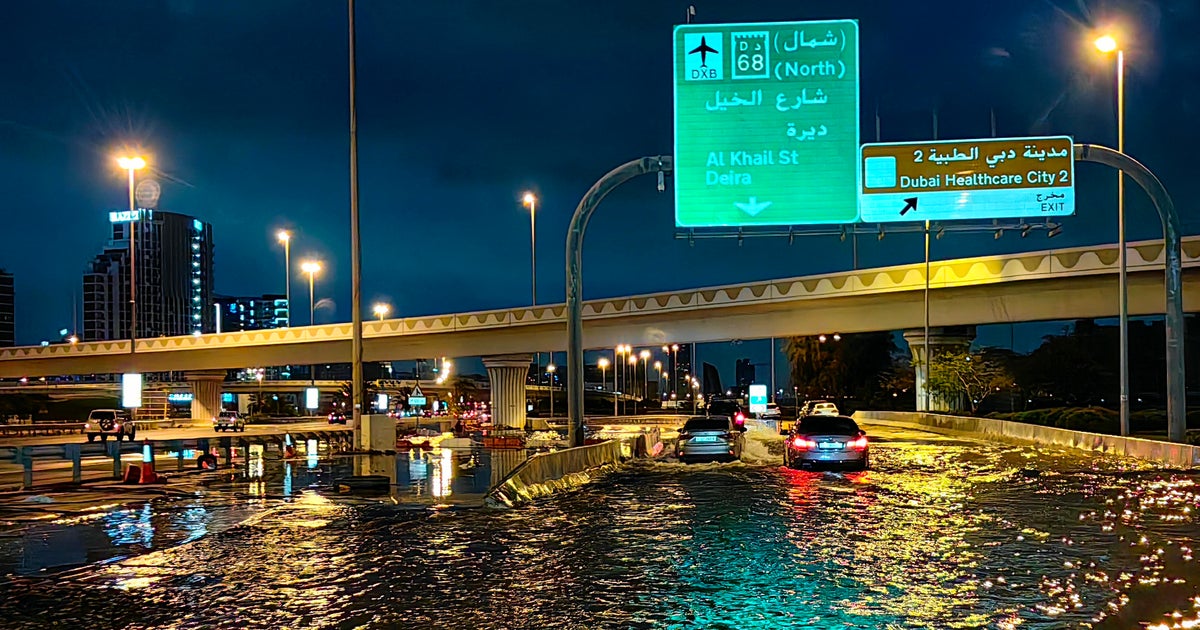Dubai, United Arab Emirates – The desert nation of the United Arab Emirates tried to dry off Wednesday from the heaviest rainfall ever recorded there after flooding at Dubai International Airport disrupted travel through the world's busiest airport for international travel. The state-run WAM news agency called Tuesday's rain “a historic meteorological event” that surpassed “anything documented since data collection began in 1949.”
According to weather data collected at Dubai International Airport, the rain started late Monday, soaking Dubai's sand and roads with about 0.79 inches of rain. The storm intensified around 9 a.m. local time on Tuesday and continued throughout the day, bringing heavy rain and hail.
Floods affect Dubai International Airport
By late Tuesday, 5.59 inches of rain drenched Dubai in just over 24 hours. Dubai International Airport receives an average of 3.73 inches of rainfall per year and is a hub for long-haul carrier Emirates.
At the airport, when the plane landed, the taxiways were waterlogged. Arrivals were halted on Tuesday night and passengers struggled to reach the terminals through floodwaters covering surrounding roads.
GIUSPPE CACACE/AFP/Getty
Airport said A series of social media posts All operations were halted for about 25 minutes on Tuesday afternoon, after which all arrivals would be diverted “until the weather condition stabilises”, the airport and Emirates said late on Wednesday morning that it was warning passengers not to come to the airport unless absolutely necessary, adding that all flight checks were still suspended.
“Flights continue to be delayed and diverted. Please check your flight directly with your airline,” the airport said in a tweet. “We are working hard to quickly restore operations in a very challenging environment.”
One couple, who spoke to The Associated Press on the condition of anonymity in a country with strict laws criminalizing critical speech, called the situation at the airport “absolute carnage.”
“You can't get a taxi. People are sleeping at the metro station. People are sleeping at the airport,” the man said on Wednesday.
They got a taxi closer to their home, 18 miles away, but flooding on the road stopped them. A man helped them over the highway barrier with their carry-on, bottles of gin they had picked up from a duty-free store.
AFP/Getty
Paul Griffiths, the airport's chief executive officer, acknowledged the continued problems with flooding on Wednesday morning, saying every space that could safely land a plane had been taken. Some flights were diverted to Al Maktoum International Airport at Dubai World Central, the city-state's second airport.
“It's been an incredibly challenging time. In living memory, I don't think anyone has ever seen conditions like this,” Griffiths told state-owned talk radio station Dubai Eye. “We're in uncharted territory, but I can assure everyone that we're working as hard as we can to make sure our customers and employees are taken care of.”
Did “cloud seeding” contribute?
Bahrain, Oman, Qatar and Saudi Arabia also received rain. However, heavy rains continue to fall across the UAE. There may be a reason”Cloud seeding,” in which small planes flown by the government would shoot special salt flares through the clouds. Those flares could increase precipitation.
Several reports cited meteorologists from the National Center for Meteorology as saying six or seven cloud seeding planes had been flown before the rain. The center did not immediately respond to questions Wednesday, although flight tracking data analyzed by the AP showed a plane linked to the United Arab Emirates' cloud seeding efforts flew across the country on Sunday.
The UAE relies heavily on energy-hungry desalination plants to supply water. Conducts cloud seeding In part to augment its dwindling, limited groundwater.
Floods close schools across UAE
Schools across the UAE, a confederation of seven shekhdoms, were closed ahead of the storm and government employees are often working remotely if they can. Many workers stayed at home, and while some went out, the unlucky ones had their vehicles blocked by deeper-than-expected water on some roads.
Abdel Hadi Ramahi/Reuters
Officials sent tanker trucks to streets and highways to clear the water. Some houses were flooded, forcing people to bail out their homes.
The country's hereditary rulers did not provide the nation with overall damage or injury figures as some slept in flooded vehicles on Tuesday night. A 70-year-old man has died after his vehicle was swept away by floodwaters in the country's northern emirate of Ras Al-Khaimah, police said.
Fujairah, an emirate on the east coast of the United Arab Emirates, saw the heaviest rainfall of 5.7 inches on Tuesday.
Officials canceled school and the government reinstated remote work on Wednesday.
Rain is uncommon in the dry, Arabian Peninsula nation of the UAE, but does occur sporadically during the cold winter months. Many roads and other areas are flooded due to lack of regular rainfall due to lack of drainage.
Meanwhile, in neighboring Oman on the eastern edge of the Arabian Peninsula, heavy rains in recent days have killed at least 19 people, the country's National Committee for Emergency Management said in a statement on Wednesday. About 10 schoolchildren were swept away in a vehicle with an adult, prompting condolences from governors across the region.
Abdel Hadi Ramahi/Reuters
Climate scientists have warned for years that human-driven Climate change as fuel More extreme and less predictable weather Events around the world.
Southern Russia and parts of Central Asia are also dealing with unusually damaging rainfall and snowmelt. More than 60 people were killed In Pakistan and Afghanistan.
